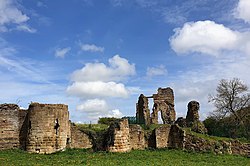
Elizabeth Cavendish, later Elizabeth Talbot, Countess of Shrewsbury, known as Bess of Hardwick, of Hardwick Hall, Derbyshire, was a notable figure of Elizabethan English society. By a series of well-made marriages, she rose to the highest levels of English nobility and became enormously wealthy. Bess was reportedly a shrewd businesswoman, increasing her assets with business interests including mines and glass-making workshops.
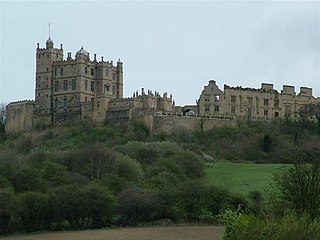
Bolsover Castle is in the town of Bolsover, in the north-east of the English county of Derbyshire. Built in the early 17th century, the present castle lies on the earthworks and ruins of the 12th-century medieval castle; the first structure of the present castle was built between 1612 and 1617 by Sir Charles Cavendish. The site is now in the care of the English Heritage charity, as both a Grade I listed building and a Scheduled Ancient Monument.

Heanor (/ˈhiːnə/) is a town in the Amber Valley district of Derbyshire in the East Midlands of England. It lies 8 miles (13 km) north-east of Derby and forms, with the adjacent village of Loscoe, the civil parish and town council-administered area of Heanor and Loscoe, which had a population of 17,251 in the 2011 census.

Eastwood is a former coal mining town in the Broxtowe district of Nottinghamshire, England, 8 miles (13 km) northwest of Nottingham and 10 miles (16 km) northeast of Derby on the border between Nottinghamshire and Derbyshire. Mentioned in Domesday Book, it expanded rapidly during the Industrial Revolution. The Midland Railway was formed here and it is the birthplace of D. H. Lawrence. The distinctive dialect of East Midlands English is extensively spoken, in which the name of the town is pronounced.
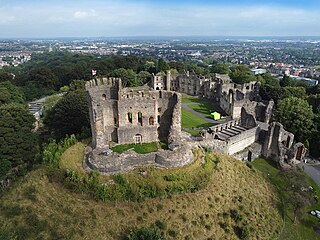
Dudley Castle is a ruined fortification in the town of Dudley, West Midlands, England. Originally a wooden motte and bailey castle built soon after the Norman Conquest, it was rebuilt as a stone fortification during the twelfth century but subsequently demolished on the orders of Henry II of England. Rebuilding of the castle took place from the second half of the thirteenth century and culminated in the construction of a range of buildings within the fortifications by John Dudley. The fortifications were slighted by order of the Parliament of England during the English Civil War and the residential buildings destroyed by fire in 1750. In the nineteenth and early twentieth century the site was used for fêtes and pageants. Today Dudley Zoo is located on its grounds.
The title of Baron Grey of Codnor is a title in the peerage of England.
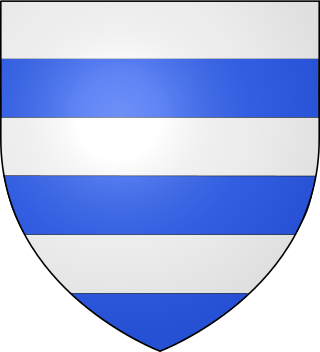
Richard de Grey of Codnor, Derbyshire, was a landowner who held many important positions during the reign of Henry III of England, including Warden of the Isles 1226–1227, 1229–1230 and 1252–1254, and later both Constable of Dover Castle and Warden of the Cinque Ports from 1258 irregularly to 1264.

Langley Mill is a large village in the Amber Valley district of Derbyshire, England.

Codnor is a village and civil parish in the Amber Valley district of Derbyshire, England. Codnor is a former mining village and had a population of 3,766 taken at the 2011 Census. It is approximately 12 miles from Derby and 14 miles from Nottingham. Codnor forms a built up area with nearby Ripley.

Heanor and Loscoe is a civil parish within the Amber Valley district, which is in the county of Derbyshire, England. Mainly built up with rural fringes, its population was 17,251 residents in the 2011 census. The parish is 120 miles (190 km) north west of London, 10 miles (16 km) north east of the county city of Derby, and contains the market town of Heanor along with other areas. It shares a boundary with the parishes of Aldercar and Langley Mill, Codnor, Denby, Shipley and Smalley.

Greasley is a civil parish north west of Nottingham in Nottinghamshire, England. Although it is thought there was once a village called Greasley, there is no settlement of that name today as it was destroyed by the Earl of Rutland. The built up areas in the parish are Beauvale, Giltbrook, Moorgreen, Newthorpe, Watnall and parts of Eastwood, Kimberley and Nuthall. There is also a small hamlet known as Bog-End. The parish is one of the largest in Nottinghamshire at 8.11 square miles (21.0 km2), and the 2001 UK Census reported it had a total population of 10,467, increasing to 11,014 at the 2011 Census.
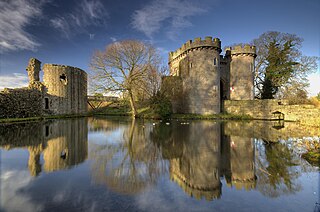
Whittington Castle is a castle in northern Shropshire, England, owned and managed by the Whittington Castle Preservation Fund. The castle was originally a motte-and-bailey castle, but this was replaced in the 13th century by one with buildings around a courtyard whose exterior wall was the curtain wall of the inner bailey. As a castle of the Welsh Marches, it was built on the border of Wales and England very close to the historic fort of Old Oswestry.

Sir Henry de Grey of Grays Thurrock, Essex (1155–1219) was a favourite courtier of King John of England.

The Honour of Peverel is a geographic area in the north of England comprising part of the historic feudal barony held by the Norman Peverel family. The honour was granted to William Peverel by William the Conqueror.
The Sheriff of Nottinghamshire, Derbyshire and the Royal Forests is a position established by the Normans in England.
Crosshill and Codnor railway station was a railway station which served the villages of Crosshill and Codnor in Derbyshire, England It was opened in 1890 by the Midland Railway on its branch between Langley Mill on the Erewash Valley Line and Ripley

Peveril Castle is a ruined 11th-century castle overlooking the village of Castleton in the English county of Derbyshire. It was the main settlement of the feudal barony of William Peverel, known as the Honour of Peverel, and was founded some time between the Norman Conquest of 1066 and its first recorded mention in the Domesday Survey of 1086, by Peverel, who held lands in Nottinghamshire and Derbyshire as a tenant-in-chief of the king. The town became the economic centre of the barony. The castle has views across the Hope Valley and Cave Dale.

Codnor Park and Ironville railway station served the villages of Codnor Park and Ironville, Derbyshire, England from 1847 to 1967 on the Erewash Valley Line.
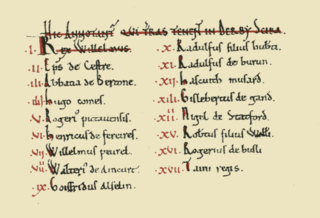
The Domesday Book of 1086 AD lists King William the Conqueror's tenants-in-chief in Derbyscire (Derbyshire), following the Norman Conquest of England:

This is a list of scheduled monuments in the district of Amber Valley in the English county of Derbyshire.
